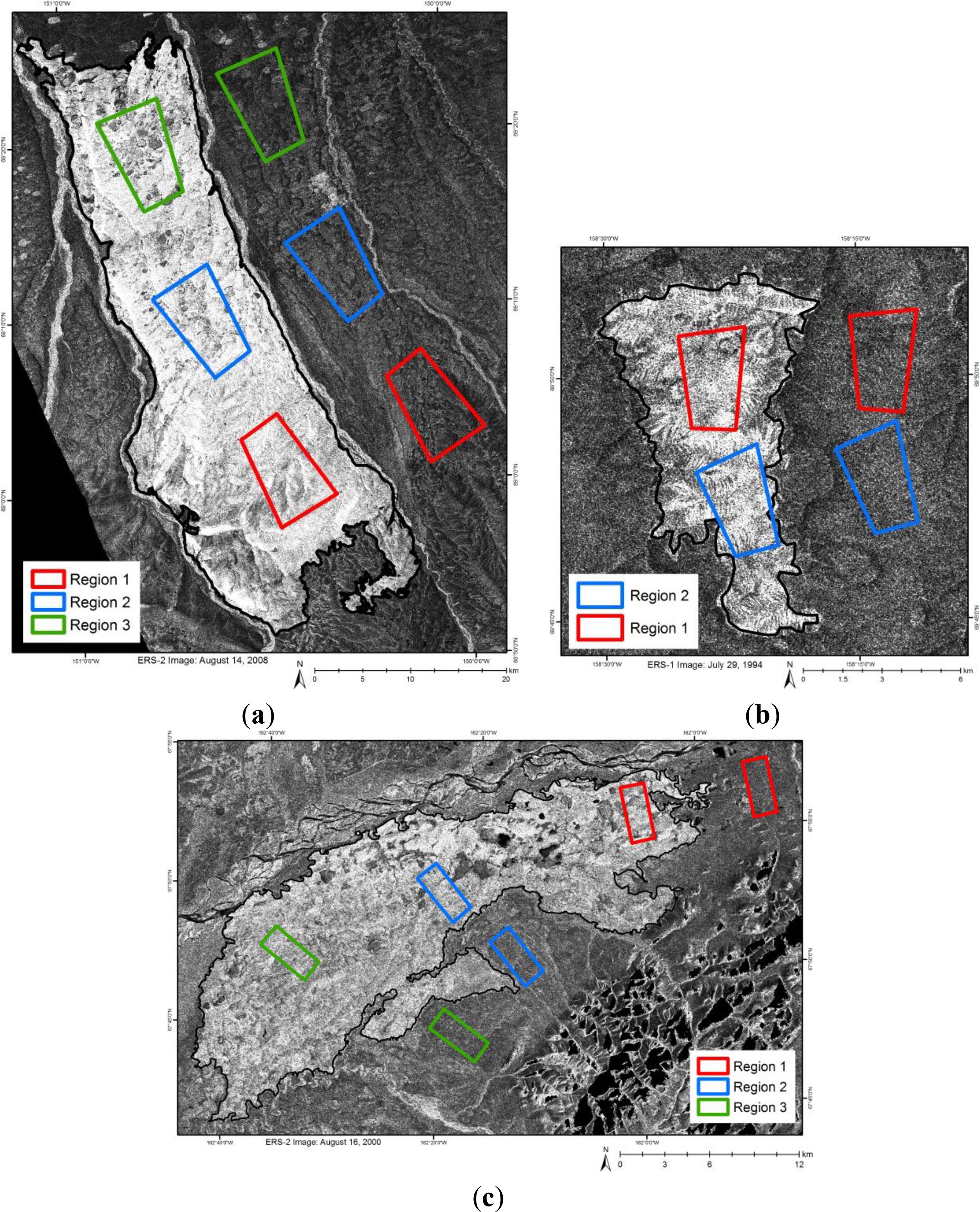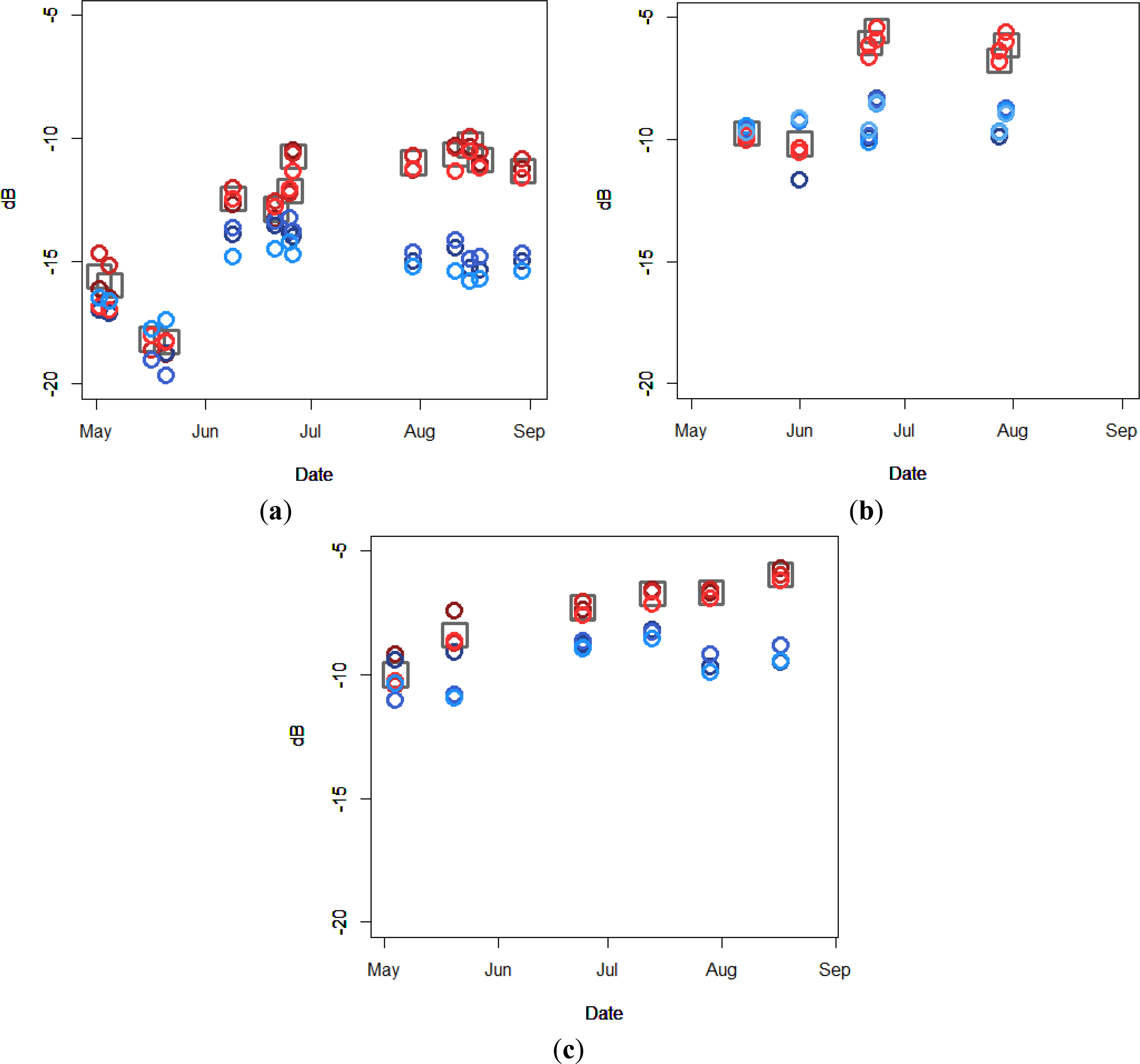Development of Methods for Detection and Monitoring of Fire Disturbance in the Alaskan Tundra Using a Two-Decade Long Record of Synthetic Aperture Radar Satellite Images
Abstract
:1. Introduction
2. Materials and Methods
2.1. Study Area
2.2. Ancillary and Remote Sensing Data
2.3. Image Processing and Analysis
- i = year
- j = region
- k = index for unburned (k = 1) and burned (k = 2)
- ib = year in which burn occured
- μi = year effect
- αj = region effect
- νi = burn effect
- εijk = error ∼ normally distributed with variance σ2
3. Results
4. Discussion
5. Conclusions
Acknowledgments
Author Contributions
Conflicts of Interest
References
- Euskirchen, E.S.; McGuire, A.D.; Chapin, F.S., III; Yi, S.; Thompson, C.C. Changes in vegetation in northern Alaska under scenarios of climate change, 2003–2100: Implications for climate feedbacks. Ecol. Appl 2009, 19, 1022–1043. [Google Scholar]
- Carroll, M.L.; Townshend, J.R.G.; DiMiceli, C.M.; Loboda, T.; Sohlberg, R.A. Shrinking lakes of the Arctic: Spatial relationships and trajectory of change. Geophys. Res. Lett 2011, 38. [Google Scholar] [CrossRef]
- Soja, A.J.; Tchebakova, N.M.; French, N.H.; Flannigan, M.D.; Shugart, H.H.; Stocks, B.J.; Sukhinin, A.I.; Parfenova, E.I.; Chapin, F.S., III; Stackhouse, P.W., Jr. Climate-induced boreal forest change: Predictions versus current observations. Glob. Planet. Chang 2007, 56, 274–296. [Google Scholar]
- Flannigan, M. Personal correspondence. 2014.
- Loboda, T.V.; French, N.H.F.; Hight-Harf, C.; Jenkins, L.; Miller, M.E. Mapping fire extent and burn severity in alaskan tussock tundra: An analysis of the spectral response of tundra vegetation to wildland fire. Remote Sens. Environ 2013, 134, 194–209. [Google Scholar]
- Hu, F.S.; Higuera, P.E.; Walsh, J.E.; Chapman, W.L.; Duffy, P.A.; Brubaker, L.B.; Chipman, M.L. Tundra burning in Alaska: Linkages to climatic change and sea ice retreat. J. Geophys. Res.: Biogeosci. (2005–2012) 2010, 115. [Google Scholar] [CrossRef]
- Bret-Harte, M.S.; Mack, M.C.; Shaver, G.R.; Huebner, D.C.; Johnston, M.; Mojica, C.A.; Pizano, C.; Reiskind, J.A. The response of arctic vegetation and soils following an unusually severe tundra fire. Philos. Trans. R. Soc. B 368, 0490.
- Jones, B.M.; Kolden, C.A.; Jandt, R.; Abatzoglou, J.T.; Urban, F.; Arp, C.D. Fire behavior, weather, and burn severity of the 2007 Anaktuvuk river tundra fire, north Slope, Alaska. Arct. Antarct. Alp. Res 2009, 41, 309–316. [Google Scholar]
- Mack, M.C.; Bret-Harte, M.S.; Hollingsworth, T.N.; Jandt, R.R.; Schuur, E.A.; Shaver, G.R.; Verbyla, D.L. Carbon loss from an unprecedented arctic tundra wildfire. Nature 2011, 475, 489–492. [Google Scholar]
- Kasischke, E.S.; Verbyla, D.L.; Rupp, T.S.; McGuire, A.D.; Murphy, K.A.; Jandt, R.; Barnes, J.L.; Hoy, E.E.; Duffy, P.A.; Calef, M.; et al. Alaska’s changing fire regime-implications for the vulnerability of its boreal forests. Can. J. For. Res 2010, 40, 1313–1324. [Google Scholar]
- Kasischke, E.S.; Rupp, T.S.; Verbyla, D.L. Fire Trends in the Alaskan Boreal Forest; Oxford University Press: New York, NY, USA, 2006. [Google Scholar]
- Wein, R.W.; Bliss, L.C. Changes in Arctic Eriophorum tussock communities following fire. Ecology 1973, 54, 845–852. [Google Scholar]
- Racine, C.H.; Dennis, J.G.; Patterson, W.A., III. Tundra fire regimes in the Noatak river watershed, Alaska: 1956–1983. Arctic 1985, 38, 194–200. [Google Scholar]
- French, N.H.F.; Jenkins, L.K.; Bourgeau-Chavez, L.L.; Loboda, T.V. Fire in arctic tundra of Alaska: Fire occurrence and implications for ecology and land management. Arct. Antarct. Alp. Res, 2014; in preparation. [Google Scholar]
- Rocha, A.V.; Loranty, M.M.; Higuera, P.E.; Mack, M.C.; Hu, F.S.; Jones, B.M.; Breen, A.L.; Rastetter, E.B.; Goetz, S.J.; Shaver, G.R. The footprint of Alaskan tundra fires during the past half-century: Implications for surface properties and radiative forcing. Environ. Res. Lett 2012, 7, 044039. [Google Scholar]
- Gallant, A.L.; Binnian, E.F.; Omernik, J.M.; Shasby, M.B. Ecoregions of Alaska; U.S. Geological Survey Professional Paper 1567; United States Government Printing: Washington, DC, USA, 1995; p. 73. [Google Scholar]
- Jones, B.M.; Breen, A.L.; Gaglioti, B.V.; Mann, D.H.; Rocha, A.V.; Grosse, G.; Arp, C.D.; Kunz, M.L.; Walker, D.A. Identification of unrecognized tundra fire events on the north slope of Alaska. J. Geophys.Res.: Biogeosci. (2005–2012) 2013, 118, 1334–1344. [Google Scholar]
- Nowacki, G.; Brock, T. Ecoregions and Subregions of Alaska, Ecomap Version 2.0; USDA Forest Service: Alaska Region, Juneau, AK, USA, 1995. [Google Scholar]
- Nowacki, G.; Spencer, P.; Fleming, M.; Brock, T.; Jorgenson, T. Ecoregions of Alaska; U.S. Geological Survey Open-File Report 02–297; USGS: Reston, VA, USA, 2001. [Google Scholar]
- CAVM Team. Circumpolar Arctic Vegetation Map. In Conservation of Arctic Flora and Fauna (CAFF) Map No. 1; U.S. Fish and Wildlife Service: Anchorage, AK, USA, 2003. [Google Scholar]
- Raynolds, M.K.; Walker, D.A.; Maier, H.A. Alaska Arctic Tundra Vegetation Map; U.S. Fish and Wildlife Service: Anchorage, AK, USA, 2006. [Google Scholar]
- Racine, C.H.; Johnson, L.A.; Viereck, L.A. Patterns of vegetation recovery after tundra fires in northwestern Alaska, USA. Arct. Alp. Res 1987, 19, 461–469. [Google Scholar]
- Chapin, F.S.; Sturm, M.; Serreze, M.C.; McFadden, J.P.; Key, J.R.; Lloyd, A.H.; Schimel, J.P.; Beringer, J.; Chapman, W.L.; Epstein, H.E.; et al. Role of land-surface changes in Arctic summer warming. Science 2005, 310, 657–660. [Google Scholar]
- Tape, K.E.N.; Sturm, M.; Racine, C. The evidence for shrub expansion in northern Alaska and the Pan-Arctic. Glob. Chang. Biol 2006, 12, 686–702. [Google Scholar]
- Racine, C.; Jandt, R.; Meyers, C.; Dennis, J. Tundra fire and vegetation change along a hillslope on the Seward Peninsula, Alaska, USA. Arct. Antarct. Alp. Res 2004, 36, 1–10. [Google Scholar]
- Grosse, G.; Harden, J.; Turetsky, M.; McGuire, A.D.; Camill, P.; Tarnocai, C.; Frolking, S.; Schuur, A.G.; Jorgenson, T.; Marchenko, S.; et al. Vulnerability of high-latitude soil organic carbon in north America to disturbance. J. Geophys. Res.: Biogeosci. 2005–2012 2011, 116. [Google Scholar] [CrossRef]
- Swanson, D.K. Susceptibility of permafrost soils to deep thaw after forest fires in Interior Alaska, USA, and some ecologic implications. Arct. Alp. Res 1996, 217–227. [Google Scholar]
- French, N.H.F.; Kasischke, E.S.; Johnson, R.D.; Bourgeau-Chavez, L.L.; Frick, A.L.; Ustin, S.L. Estimating Fire-Related Carbon Flux in Alaska Boreal Forests Using Multi-Sensor Remote Sensing Data. In Biomass Burning and Global Change; Levine, J.S., Ed.; MIT Press: Cambridge, MA, USA, 1996; pp. 808–826. [Google Scholar]
- Bourgeau-Chavez, L.L.; Harrell, P.A.; Kasischke, E.S.; French, N.H. The detection and mapping of Alaskan wildfires using a spaceborne imaging radar system. Int. J. Remote Sens 1997, 18, 355–373. [Google Scholar]
- Bourgeau-Chavez, L.L.; Kasischke, E.S.; Riordan, K.; Brunzell, S.; Nolan, M.; Hyer, E.; Slawski, J.; Medvecz, M.; Walters, T.; Ames, S. Remote monitoring of spatial and temporal surface soil moisture in fire disturbed boreal forest ecosystems with ERS SAR imagery. Int. J. Remote Sens 2007, 28, 2133–2162. [Google Scholar]
- Kasischke, E.S.; Bourgeau-Chavez, L.L.; French, N.H.F.; Harrell, P.; Christensen, N.L., Jr. Initial observations on using SAR to monitor wildfire scars in boreal forests. Int. J. Remote Sens 1992, 13, 3495–3501. [Google Scholar]
- Reschke, J.; Bartsch, A.; Schlaffer, S.; Schepaschenko, D. Capability of C-band SAR for operational wetland monitoring at high latitudes. Remote Sens 2012, 4, 2923–2943. [Google Scholar]
- Bourgeau-Chavez, L.L. Using ERS-1 SAR Imagery to Monitor Variations in Burn Severity in an Alaskan Fire-Disturbed Boreal Forest Ecosystem; University of Michigan: Ann Arbor, MI, USA, 1994. [Google Scholar]
- Kasischke, E.S.; Morrissey, L.; Way, J.; French, N.H.F.; Bourgeau-Chavez, L.L.; Rignot, E.; Stearn, J.A.; Livingston, G.P. Monitoring seasonal variations in boreal ecosystems using multitemporal spaceborne SAR data. Can. J. Remote Sens 1995, 21, 96–109. [Google Scholar]
- Boggs, K.; Boucher, T.V.; Kuo, T.T.; Fehringer, D.; Guyer, S. Vegetation Map and Classification: Northern, Western and Interior Alaska; Alaska Natural Heritage Program, University of Alaska Anchorage: Anchorage, AK, USA, 2012. [Google Scholar]
- Kasischke, E.S.; Williams, D.; Barry, D. Analysis of the patterns of large fires in the boreal forest region of Alaska. Int. J. Wildland Fire 2002, 11, 131–144. [Google Scholar]
- Albright, W. Calibration Report for ERS-1 and ERS-2 on the Precision Processor; Alaska Satellite Facility: Fairbanks, AK, USA, 2000. [Google Scholar]
- Bourgeau_Chavez, L.L.; Kasischke, E.S.; Brunzell, S.M.; Tukman, M.; Mudd, J.P. Mapping fire scars in global boreal forests using imaging radar data. Int. J. Remote Sens 2002, 22, 3665–3687. [Google Scholar]
- Bourgeau-Chavez, L.; Jenkins, L.; Harden, J.; French, N.H.F. Assessment of decadal trends in satellite radar backscatter from alaskan tundra in relation to soil moisture. Geophys. Res. Lett 2014. in preparation.. [Google Scholar]





| Fire | Year of Burn | Fire Duration | Fire Size | Area Burned (km2) | Location | Years of ERS SAR Data Available |
|---|---|---|---|---|---|---|
| Anaktuvuk River | 2007 | 16 July–9 October | Large | 1039 | North Slope Foothills | 15 pre-burn/3 post-burn |
| Uvgoon Creek | 1999 | 26 June–3 August | Medium | 359 | Noatak National Preserve | 7 pre-burn/11 post-burn |
| DCKN178 | 1993 | 9 July–17 August | Small | 68 | North Slope Foothills | 1 pre-burn/16 post-burn |
| 1992 | 1993 | 1994 | 1995 | 1996 | 1997 | 1998 | 1999 | 2000 | 2001 | 2002 | 2003 | 2004 | 2005 | 2006 | 2007 | 2008 | 2009 | 2010 | |
|---|---|---|---|---|---|---|---|---|---|---|---|---|---|---|---|---|---|---|---|
| Anaktuvuk River | 6 | 5 | 5 | 10 | 1 | 3 | 2 | 6 | 8 | 6 | 6 | 7 | 10 | 10 | 11 | 12 | 9 | 7 | 8 |
| DCKN178 | 5 | 4 | 4 | 5 | 0 | 4 | 4 | 7 | 4 | 1 | 3 | 2 | 2 | 4 | 4 | 4 | 4 | 4 | 6 |
| Uvgoon Creek | 5 | 5 | 2 | 4 | 2 | 0 | 3 | 7 | 5 | 5 | 6 | 4 | 3 | 4 | 4 | 3 | 5 | 6 | 3 |
| DCKN178 | |||
| Region 1 | Region 2 | ||
| Region 1 | |||
| Region 2 | 0.097 | ||
| Anaktuvuk River | |||
| Region 1 | Region 2 | Region 3 | |
| Region 1 | |||
| Region 2 | 0.428 | ||
| Region 3 | <0.001 * | <0.001 * | |
| Uvgoon Creek | |||
| Region 1 | Region 2 | Region 3 | |
| Region 1 | |||
| Region 2 | 0.001 * | ||
| Region 3 | 0.004 * | 0.956 |
| εijk Std. Err. | νi Std. Err. | |
|---|---|---|
| Anaktuvuk River | 0.005868 | 0.004792 |
| DCKN178 | 0.004062 | 0.0040616 |
| Uvgoon Creek | 0.01319 | 0.010768 |
© 2014 by the authors; licensee MDPI, Basel, Switzerland This article is an open access article distributed under the terms and conditions of the Creative Commons Attribution license (http://creativecommons.org/licenses/by/3.0/).
Share and Cite
Jenkins, L.K.; Bourgeau-Chavez, L.L.; French, N.H.F.; Loboda, T.V.; Thelen, B.J. Development of Methods for Detection and Monitoring of Fire Disturbance in the Alaskan Tundra Using a Two-Decade Long Record of Synthetic Aperture Radar Satellite Images. Remote Sens. 2014, 6, 6347-6364. https://doi.org/10.3390/rs6076347
Jenkins LK, Bourgeau-Chavez LL, French NHF, Loboda TV, Thelen BJ. Development of Methods for Detection and Monitoring of Fire Disturbance in the Alaskan Tundra Using a Two-Decade Long Record of Synthetic Aperture Radar Satellite Images. Remote Sensing. 2014; 6(7):6347-6364. https://doi.org/10.3390/rs6076347
Chicago/Turabian StyleJenkins, Liza K., Laura L. Bourgeau-Chavez, Nancy H. F. French, Tatiana V. Loboda, and Brian J. Thelen. 2014. "Development of Methods for Detection and Monitoring of Fire Disturbance in the Alaskan Tundra Using a Two-Decade Long Record of Synthetic Aperture Radar Satellite Images" Remote Sensing 6, no. 7: 6347-6364. https://doi.org/10.3390/rs6076347





